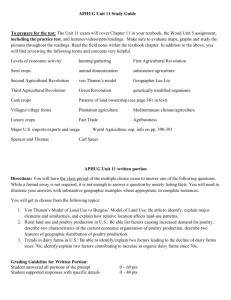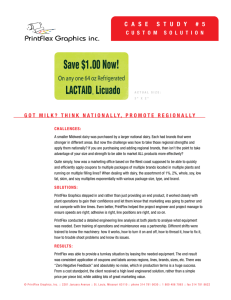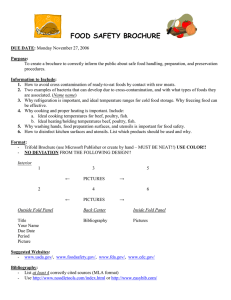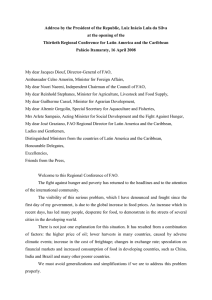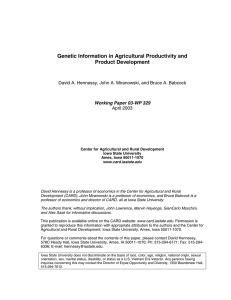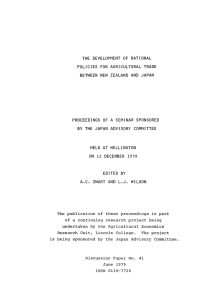Pathways for Growth: 2011 Update
advertisement
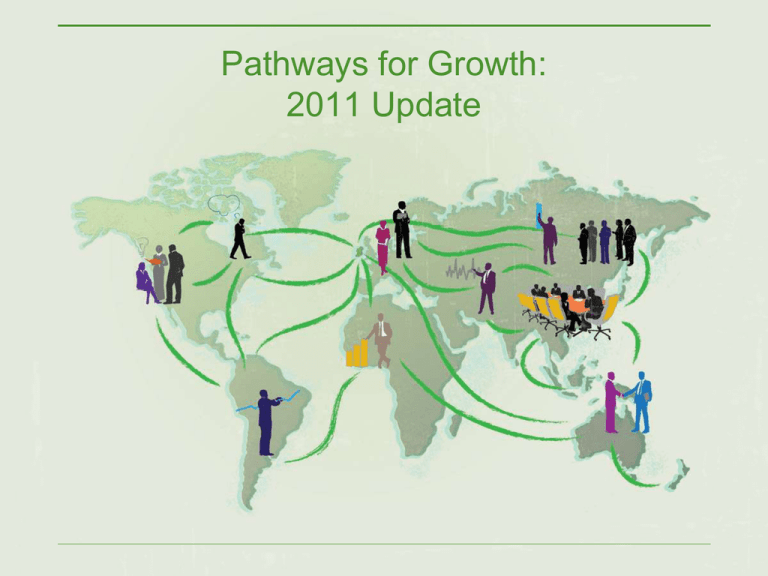
Pathways for Growth: 2011 Update Agenda • • • Pathways for Growth News from the world News from Ireland Ireland has an enviable agricultural situation that almost every other country would kill for… … at a time when the global demand for food is projected to increase by 70% over the next 40 years. Pathways for Growth • • Challenges – Fragmentation – Lack of consumer orientation – Low confidence in the future Solutions – Cooperation instead of competition (Co-opetition) – Innovation leading to differentiation – Brands built around customer feedback – Umbrella strategy “Come See Us” • • • • World class agricultural industry by 2016 “We are natural and we can prove it” – Tough standards – Universal adoption Work as one to achieve export growth Umbrella brand for Irish food and drink Trends in the Global Food System 2011 Prices at Record Levels Source: FAO • Fundamental Shift Supply – Demand Balance – China, others eating more meat – Biofuels use continues – Productivity growth not keeping pace • New land = marginal land • Low investment R&D China China • • Relentless urbanization – 2011: 160 cities 1 M+ (35 in Europe!) – 2025: 219 cities 1 M+; 24 > 5 M – 2030: 1 BILLION in cities Losing land – Houses, offices, roads, factories, desertification China • • • • Food policy under review – Produce? Import? 50% of soybean exports go to China Largest corn imports in 15 years FDI $12 B in Brazil in 2011 ($82 M in 2008) – Also Africa, New Zealand…. China’s Challenge: From quantity to quality • Food safety incidents continue – Technology – Brands • Obesity a growing problem – KFC’s “New Fast Food” China will affect your business • • • • Market? Competitor? Partner? Price “When I go back to the US, it’s like a movie playing in slow motion.” Brazil Brazil has 19% of the world’s arable land. More than 100 million hectares to be used in Cerrado Brazil • Economy strong, domestic demand growing – Inflation 6.4% • Labor shortages – Skilled workers – Management Brazil’s agricultural strategy? Brazilian Real is Strengthening… • • Making Brazilian production more expensive … and international acquisitions cheaper • JBS – Global footprint = Market access – Acquisitions: Argentina, Australia, USA – Beef, swine, poultry – 2010 Revenues $33 billion – Execution/Efficiency • 15 M head cattle slaughtered 2009 • Brasil Foods – Merger Perdigão & Sadia (2009) – Poultry, pork, dairy – Nestlé strategy • Processed foods + Brands – Targets: Africa, Middle East, Latin America – 2010 Revenues $14 billion Key Trends • • • Volatility Sustainability Technology Volatility • No end in sight Cereal production, utilization and stocks Source: FAO % Return – Agricultural Commodities vs. Bonds 2 Year Source: Michael Filighera, Seeking Alpha, January 21, 2011 Environmental Sustainability • Coca-Cola – Secure supply • McDonald’s – Consumer confidence • Nestle – “Shared Value” – Embedded in individual brand propositions Sustainability • • • • • Defense? Lower costs? Differentiator? Barrier to entry? Necessary but not sufficient for a premium price Good for You, Good for the Environment Source: Barilla Center for Food and Nutrition Technology • • • Personalized diets – 23andMe.com – Nestlé • Imaging work with GE • Acquired Prometheus • Jenny Craig Traceability – There’s an App for that! – Ice Breaker (New Zealand) – HarvestMark (USA) – thisfish (Canada) Social Media Predictions – May 2010 (also 2011) • Commodity prices will be volatile – Biofuels will shift to efficient feedstock (not corn) – Food security v. free trade – End of “very cheap food” • High fuel costs will drive re-examination of supply chains – Efficient production and transportation – Local, national, or global production? – Approach to inventories (stocks) – Infrastructure a growing bottleneck • Substantial change in investment flows – Global business models for production (e.g., beef, poultry, dairy) – Food security for buying nations – Increased interest in sector • Venture capital, sovereign wealth funds Predictions – May 2011 • Commodity prices will be volatile – Biofuels will shift to efficient feedstock (not corn) – Food security v. free trade – End of “very cheap food” • High fuel costs will drive re-examination of supply chains – Efficient production and transportation – Local, national, or global production? – Approach to inventories (stocks) – Infrastructure a growing bottleneck • Substantial change in investment flows – Global business models for production (e.g., beef, poultry, dairy) – Food security for buying nations – Increased interest in sector • Venture capital, sovereign wealth funds News from Home Industry Optimism • • • Competitiveness Talent Market Government Support • • • Food Harvest 2020 Commitment Reality Capital is Available • • • Large firms with viable strategies SME less access Global investment in sector – Banks and funds – Consolidation and globalization Export or Perish • • • • Growth outside of Ireland Clarifies decision making Scale Customer orientation
